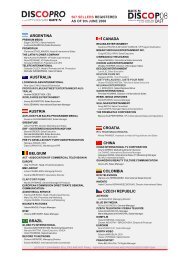TELENOVELA BLOCK.pages 24 - 30: - Discop
TELENOVELA BLOCK.pages 24 - 30: - Discop
TELENOVELA BLOCK.pages 24 - 30: - Discop
Create successful ePaper yourself
Turn your PDF publications into a flip-book with our unique Google optimized e-Paper software.
portrait<br />
A GOOD FRIEND – MICHEL RODRIGUE<br />
By Bob Jenkins<br />
When it comes to doing business<br />
in the CEE, Michel Rodrigue,<br />
CEO and President of Canadian format<br />
distributor, Distraction Formats, is a<br />
man with form as well as formats. The<br />
company was founded in 1989,<br />
launching at MIPCOM in the autumn of<br />
that year. “And,” recalls Rodrigue, “the<br />
very first sale recorded by the then<br />
fledgling outfit, was to a Polish producer<br />
of a Canadian format, THE MAD<br />
DASH. The producer sold it on to TVP,<br />
and the show ran in Poland for a total<br />
of 115 episodes.”<br />
This might have been the first<br />
experience Distraction had in the<br />
region, but it was not Rodrigue’s first<br />
exposure to Eastern Europe. In 1989,<br />
just at the very moment communism<br />
was falling, Rodrigue was part of a<br />
Quebecois delegation that visited<br />
Czech Republic and successfully negotiated<br />
a co-production agreement<br />
between the republic and Quebec.<br />
Poland was Distraction’s first sale<br />
in the CEE, and despite the company<br />
now doing business, per Rodrigue, “in<br />
virtually every country in the region,<br />
Poland,” he says, “remains the company’s<br />
most important market in the<br />
region.” And it might be about to<br />
become more significant.<br />
One of the techniques which has<br />
been very important to Distraction‘s<br />
expansion in the region is one known<br />
as “carousel production.” This is the<br />
process by which one set is built in a<br />
chosen location for a given format,<br />
and one crew becomes versed in the<br />
techniques of the show, and then presenters<br />
and contestants are brought<br />
in from neighbouring countries and<br />
the same crew and set are used to<br />
produce several different versions,<br />
allowing the cost to be amortised over<br />
a number of different productions.<br />
Poland has run two seasons of<br />
what Rodrigue describes as, “a big,<br />
SATURDAY NIGHT FEVER style format<br />
from Italy called CIAO DARWIN”. As<br />
Poland is preparing to shoot its third<br />
season, there is a lot of interest from<br />
surrounding countries such as<br />
Hungary, Bulgaria and Romania, and<br />
possible interest from Russia as well.<br />
In many ways, this is the logical<br />
continuation of what Rodrigue sees as<br />
an ongoing process that started with<br />
the fall of communism. “Obviously,”<br />
says Rodrigue, “before communism<br />
was overthrown in this part of the<br />
world, there were no commercial stations,<br />
and, just as obviously, there<br />
were no independent producers. Once<br />
communism went, many western<br />
companies such as SBS and ViaSat<br />
moved in to open stations. But they<br />
needed a viable independent sector,<br />
and so, they set about helping to create<br />
one. And, they succeeded.”<br />
Although Rodrigue celebrates the<br />
successful birth of the independent<br />
sector in the CEE, it was not, he notes,<br />
without its birth pangs. “Initially,”<br />
recalls Rodrigue, “there was a question<br />
of technical and creative communication.<br />
The people of the region have<br />
always been very creative, but under<br />
communism, this creativity was channelled<br />
in a very specific manner. Also,”<br />
he continues, “this creativity was ope -<br />
rating with technology that was<br />
increasingly antiquated, film, and only<br />
the very earliest form of video. This led<br />
to a situation, once free enterprise<br />
was introduced, in which the new independent<br />
production sector in the CEE<br />
immediately upgraded the technology<br />
to state of the art, often putting them<br />
ahead of the West where conversion<br />
costs had to be amortised, but in<br />
which they were still imbued with the<br />
old creative styles.” But Rodrigue is<br />
insistent that all of that, “is now in the<br />
past,” and that there is now a vibrant<br />
and successful independent production<br />
sector which bodes well for the<br />
future of the region.<br />
In fact, one of the things he celebrates<br />
most in the region is that,<br />
“unlike many other parts of the world,<br />
when it comes to formats, they are<br />
not, unlike most other regions of the<br />
world, wedded to formats from the UK<br />
and the US; in fact, reports Rodrigue,<br />
“90% of the formats we sell in the<br />
region are from Germany, Italy,<br />
Canada and France.”<br />
Finally, and possibly most encouragingly,<br />
Michel Rodrigue believes that,<br />
in the format business, the CEE is laying<br />
the foundations of a solution to its<br />
biggest challenge. “That challenge,”<br />
insists Rodrigue, “is the successful<br />
export of their own formats.” But with<br />
the carousel production method<br />
Distraction has pioneered in the<br />
region, a healthy market in format<br />
sales is developing between various<br />
CEE countries and, believes Rodrigue,<br />
“it will only be a matter of time before<br />
that success begins to be exported to<br />
other countries around the world.” }<br />
08<br />
discop link 03 www.discop.com march 2006
















